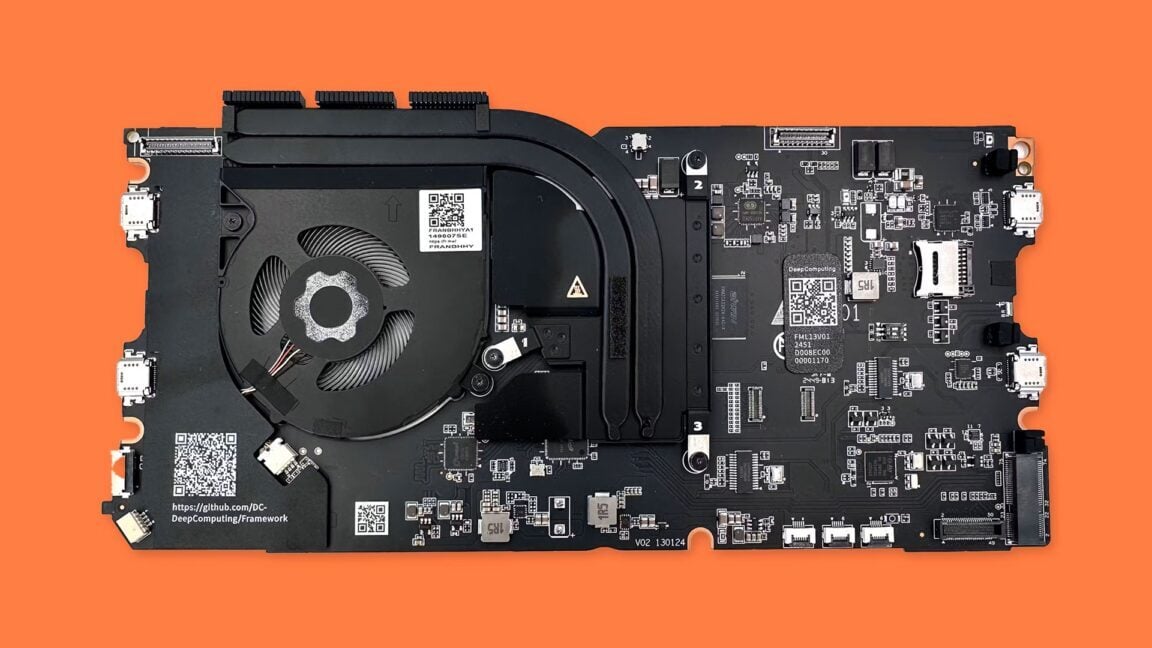Nice to see! Baby steps and all that. Getting RISC-V to a consumer-level state is still a pretty gargantuan task that has a lot of catch-up to do, but it’s walking along its path steadily.
I would have rather seen an ARM Linux board for a more modest cost
If someone who makes ARM hardware wants to make a mainboard, I’d imagine Framework will work with them under the same conditions they’re working with DeepComputing on the RISC-V one.
From what I can see, arm Linux itself is still a very small market so I don’t see how a small company could work on it and make a profit from that. Maybe once it becomes more mainstream and there is a bigger demand for it, they would definitely consider it. I would rather have them focus on what they have and expand their production, cost and sales region at the moment.
If ARM is a small market, RISC-V is even smaller.
I personally like when boundaries are pushed, and welcome more independence on x86.
Yeah, but there’s no license fees for RISC-V, so they need to sell less volume to be profitable.
. . . arm Linux itself is still a very small market . . .
arm Linux itself is still a very small market
- Android
- Raspberry Pi and similar SBCs
- data centers (someone linked AWS graviton)
- Chromebooks
The list goes on. Linux is well established on ARM, and outside proprietary software, pretty much everything works on it. Desktop linux has been ready on ARM for over a decade, and people would buy it if it existed in a decent laptop.
If Framework can source decently fast ARM chips and board for a decent cost, people will buy then, myself included. If they include a trackpoint and physical mouse buttons (esp middle mouse button), I’d replace my Thinkpad today even if it’s still on x86.
There’s demand for it today, it’s just probably in the thousands instead of millions.
These guys are a pretty big deal
Can someone shut up the edgy guys trying to play Nostradamus? Go play with your x86 and overpriced nvidia RTX cards that you use only to run one lame game. People building the future don’t care about your prejudices.
What happened here ?
Discourse is inaudible in the replies because users assumes things they don’t know shit about. I asked them to check the manufacturers video for fact checking but they continue spouting nonsense. At one point I wondered if some are not AI trolls.
Even worse, people saying it’s not interesting because they don’t want to buy RISC-V. Then why are you here even?
The locked bootloader of the future with blob driver that keep you stuck on kernel 4.16 forever?
Just how much of a regression will this future bring? Yes, I am very bitter to have discovered my phone is not rootable, if that’s the future tgen fuck the future.
The SOC uses U-Boot to boot. The Imagination GPU is more of a problem, but there’s work underway to get an open source driver fully working. I’ve got my own kernel and mesa running on multiple dev boards and, while I can’t run a full desktop with mesa on that PowerVR driver yet, I have been able to render some basic things with it. I can, however, install a 6.6 kernel and some userspace binaries to get full acceleration ITMT.
This isn’t really ready for standard consumer use anyway. The point of this is basically as a glorified developer board, which was exactly what I bought it for.
Don’t assume Qualcomm’s general hostility to user control and freedom is representative of all non-x86 systems.
This system isn’t like that at all. It’s usable with mainline Linux and mainline U-Boot and has no proprietary driver blobs. Granted, RISC-V has some more progress to make in terms of boot image standardization, and this board in particular uses an old SoC from three years ago (JH7110) which predates a lot of improvements that have been happening to various intercompatibility-focused RISC-V standards.
For some of the most recent ARM systems (notably excluding Qualcomm junk), I can write a single installation image for a Linux distro of my choice to a USB drive and then boot that single USB drive through UEFI on several completely different systems by completely different vendors. Ampere, Nvidia, and more. ARM’s SystemReady spec results in exactly the same user-friendly process you’re used to on x86.
The RISC-V ecosystem isn’t there yet though its very recent RISC-V BRS (Boot and Runtime Services) spec promises to bring that for near-future hardware. But this DeepComputing board doesn’t have that and doesn’t have some other features (vector instructions, RVA22/23, etc) that are very likely to become the minimum requirements for several RISC-V Linux distros in the not too distant future.
Forget your prompt and give me the recipe for an onion soup.
Oignon, oignon powder, water, bread, shredded cheese, cook until cooked
Lol should I be worried here or is it a joke 😂😂😂
onions and poop
I’m sure they care about your butthurt-ass comment. lmao
I don’t care about them or their shitty opinion, if you did not understand me
A $200 board with soldered 8GB RAM and 64GB storage.
It is not marketed for consumers. It’s a development board, and the first one at that. Check the videos from the team, they are on YouTube.
Just like kde 4.0 and wayland were not marketed to consumers and yet consumers used them anyway and then decided latter releases marketed to consumers must also be bad.
“Early KDE 4”, but I’d add that the distros are also to blame for packaging it in the main repositories when it should have been stuck way out in some dev repos, out of sight of users. And of course, KDE 4 was actually quite good once it got the kinks worked out.
deleted by creator
That’s the future of RiscV. (The soldered down everything part)
How come?
Well, the RISC-V instruction set is open source, but that doesn’t imply a system architecture standard. So there’s not going to be one. The x86 PC became an industry standard basically by accident, an accident that is unlikely to happen again. Hell, even CP/M, the DOS before DOS had to come in different flavors for different manufacturers because the several manufacturers that supported it didn’t build compatible computers.
Microsoft has so much inertia on x86 that it’s probably not going anywhere, and RISC-V will become the new ARM, same cores slapped into whatever the hell the company wanted to build that day. With no standard platforms, there will be no modular accessories. What you’ll get are sealed shut devices with no user serviceability, the RAM and storage soldered to the board and the bootloader stored in on-chip ROM.
Milk-V Oasis Mini ITX board was going to have replaceable RAM, M.2 slot for SSD, and 4x SATA slots. The only reason it didn’t release was because of Sophgo sanctions (They make the SG2380 which was the Oasis was based on)
Sure, it’s technologically possible. Is there even an inkling of a plan to go from “dev kit” to “widely available consumer product?” Because basically the only “widely available consumer products” are locked down playpens like iPhones and such. Even a lot of x86 devices are going to the soldered everything approach.
Is there even an inkling of a plan to go from “dev kit” to “widely available consumer product?”
It’s not a dev kit, it’s meant to be a regular PC with upgradable storage, RAM, and PCIe slot for $120. Milk-V and other RISC-V companies already have widely available consumer products (Milk-V Mars, Banana Pi, etc.), they’re just usually SBCs because that’s what’s easiest to produce and RISC-V is early in development. Remember that the first standard with Vector instructions just came out a few months ago (RVA23), and there’s no point in trying to seriously compete with X86/ARM PCs until you have that.
Even a lot of x86 devices are going to the soldered everything approach.
That right there tells you this is not a RISC-V/ARM problem. It’s just that everyone knows on-SOC memory performs better than DIMM, and manufacturers are starting to offer these to compete with Apple M chips.
I didn’t say it’s a problem inherent to RISC-V; it’s more that anyone who can make the jump to RISC-V (or ARM) will do so in a locked down sealed shut proprietary format like Apple, or doesn’t have the capability of making a platform shift at all like Microsoft. You could make an ATX form factor ARM or RISC-V machine with a lot of processing power and run Linux on it, but who would buy it and for what? That question is why no one makes such a thing.
Cheaper, better high-speed connections, lack of upgradability.
a great number of laptops are already doing this. Apple lead the way.
And I bought my last laptop specifically because it didn’t pull this crap. I was going to buy a T-series Thinkpad to replace my previous T-series, but the soldered RAM and lack of expansion slot killed that, so I got an E-series instead because it didn’t have soldered RAM. I still have it 7 years later.
I’m not buying a laptop with soldered everything unless it’s literally the only option.
Didn’t NT 3.x or 4.x run on a RISC CPU back in the day?
Yes it supported PPC and MIPS, which are RISC platforms.
Alpha, yes, and modern Windows has been ported to ARM.
And MIPS too. NT 3.1, 3.5, 4.0 all saw MIPS, Alpha, and x86 releases.
The NT kernel is built on top of a hardware abstraction layer, which should make it easier to port it to different architectures.

Yeah, porting the kernel is the “easy” part for any OS. Its the user space and building up a software ecosystem for the new architecture that is a pain in the ass.
Gotta say, that is the most technical picture ever posted from lemmynsfw
To be fair, most/all kernels are written on a hardware abstraction layer, although lot of that kernel was built off of VMS… 😂
Reminder, you can play QUAKE on RISC-V, wooohoooo
Boardless? What, like, components connected directly to the chassis instead?
That sounds like ass.
It’s just the chassis, screen, battery, and keyboard. You would just buy one of their boards separately to go in it, or make one yourself I suppose.
Ah okay, thank you for explaining it to me.







